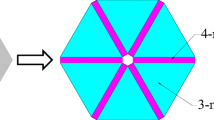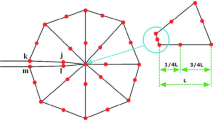Abstract
In the present work, element-free Galerkin method (EFGM) has been extended and implemented to simulate thermal fracture in functionally graded materials. The thermo-elastic fracture problem is decoupled into two separate parts. Initially, the temperature distribution over the domain is obtained by solving the heat transfer problem. The temperature field so obtained is then employed as input for the mechanical problem to determine the displacement and stress fields. The crack surfaces are modelled as non-insulated boundaries; hence the temperature field remains undisturbed by the presence of crack. A modified conservative M-integral technique has been used in order to extract the stress intensity factors for the simulated problems. The present analysis shows that the results obtained by EFGM are in good agreement with those available in the literature.






















Similar content being viewed by others
References
Koizumi M 1997 FGM activities in Japan. Compos. Part B: Eng. 8368: 1–4
Barthel K and Rambert S 1999 Thermal spraying and performance of graded composite cathodes as SOFC-component. Mater. Sci. Forum 308: 800–805
Hart N T, Brandon N P, Day M J and Shemilt J E 2001 Functionally graded cathodes for solid oxide fuel cells. J. Mater. Sci. 36(5): 1077–1085
Liu Y, Compson C and Liu M 2004 Nanostructured and functionally graded cathodes for intermediate temperature solid oxide fuel cells. J. Power Sources 138(1): 194–198
Coomar N and Kadoli R 2010 Comparative analysis of steady state heat transfer in a TBC. Sadhana – Acad. Proc. Eng. Sci. 35(1): 1–17
Gibson R E 1967 Some results concerning displacements and stresses in a non-homogeneous elastic half-space. Geotechnique 17(1): 58–67
Atkinson C and List R D 1978 Steady state crack propagation into media with spatially varying elastic properties. Int. J. Eng. Sci. 16(10): 717–730
Dhaliwal R S and Singh B M 1978 On the theory of elssticity of a nonhomogeneous medium. J. Elast. 8(2): 211–219
Delale F and Erdogan F 1983 The crack problem for a nonhomogeneous plane. J. Appl. Mech. 50(3): 609–614
Jin Z H and Noda N 1993 An internal crack parallel to the boundary of a nonhomogeneous half plane under thermal loading. Int. J. Eng. Sci. 31(5): 793–806
Erdogan F 1995 Fracture mechanics of functionally graded materials. Compos. Eng. 5(7): 753–770
Gu P and Asaro R J 1997 Cracks in functionally graded materials. Int. J. Solids Struct. 34(1): 1–17
Gu P, Dao M and Asaro R J 1999 A simplified method for calculating the crack-tip field of functionally graded materials using the domain integral. J. Appl. Mech. 66(1): 101–108
Chen J, Wu L and Du S 2000 A modified J integral for functionally graded materials. Mech. Res. Commun. 27(3): 301–306
Marur P R and Tippur H V 2000 Numerical analysis of crack-tip fields in functionally graded materials with a crack normal to the elastic gradient. Int. J. Solids Struct. 37(38): 5353–5370
Kim J and Paulino G H 2002 Finite element evaluation of mixed mode stress intensity factors in functionally graded materials. Int. J. Numer. Methods Eng. 53(8): 1903–1935
Chi S and Chung Y 2003 Cracking in coating–substrate composites with multi-layered and FGM coatings. Eng. Fract. Mech. 70: 1227–1243
Rangaraj S and Kokini K 2003 Estimating the fracture resistance of functionally graded thermal barrier coatings from thermal shock tests. Surf. Coat. Technol. 173(3): 201–212
Çallio˘glu H 2011 Stress analysis in a functionally graded disc under mechanical loads and a steady state temperature. Sadhana – Acad. Proc. Eng. Sci. 36(February): 53–64
Saucedo-mora L, Sláme K, Thandavamoorthy U and Marrow T J 2015 Multi-scale modeling of damage development in a thermal barrier coating. Surf. Coat. Technol. 276: 399–407
Afsar A M and Song J I 2010 Effect of FGM coating thickness on apparent fracture toughness of a thick-walled cylinder. Eng. Fract. Mech. 77(14): 2919–2926
Rao B N and Rahman S 2003 Mesh-free analysis of cracks in isotropic functionally graded materials. Eng. Fract. Mech. 70(1): 1–27
Dai K Y, Liu G R, Han X and Lim K M 2005 Thermomechanical analysis of functionally graded material (FGM) plates using element-free Galerkin method. Comput. Struct. 83(17–18): 1487–1502
Dolbow J E and Gosz M 2002 On the computation of mixed-mode stress intensity factors in functionally graded materials. Int. J. Solids Struct. 39(9): 2557–2574
Natarajan S, Baiz P M, Bordas S, Rabczuk T and Kerfriden P 2011 Natural frequencies of cracked functionally graded material plates by the extended finite element method. Compos. Struct. 93(11): 3082–3092
Bayesteh H and Mohammadi S 2013 XFEM fracture analysis of orthotropic functionally graded materials. Compos. Part B Eng. 44(1): 8–25
Belytschko T, Lu Y Y and Gu L 1994 Element free Galerkin methods. Int. J. Numer. Methods Eng. 37(2): 229–256
Belytschko T and Fleming M 1999 Smoothing, enrichment and contact in the element-free Galerkin method. Comput. Struct. 71(2): 173–195
Belytschko T, Krongauz Y, Fleming M, Organ D and Snm Liu W K 1996 Smoothing and accelerated computations in the element free Galerkin method. J. Comput. Appl. Math. 74(1–2): 111–126
Sladek J and Sladek V 1997 Evaluation of T-stresses and stress intensity factors in stationary thermoelasticity by the coservation integral method. Int. J. Fract. 86(3): 199–219
Paulino G H and Kim J H 2005 Consistent formulations of the interaction integral method for fracture of functionally graded materials. J. Appl. Mech. 72(3): 351–364
Wilson W K and Yu I W 1979 The use of the J-integral in thermal stress crack problems. Int. J. Fract. 15(4): 377–387
Rice J R 1968 A path independent integral and the approximate analysis of strain concentration by notches and cracks. J. Appl. Mech. 35(2): 379
Amit K C and Kim J H 2008 Interaction integrals for thermal fracture of functionally graded materials. Eng. Fract. Mech. 75(8): 2542–2565
Erdogan F and Wu B H 1997 The surface crack problem for a plate with functionally graded properties. J. Appl. Mech. 64(3): 449–456
Chen J, Wu L Z and Du S Y 2000 Element-free Galerkin methods for fracture of functionally-graded materials. Key Eng. Mater. 183: 487–492
Duflot M 2008 The extended finite element method in thermoelastic fracture mechanics. Int. J. Numer. Methods Eng. 74(5): 827–847
Author information
Authors and Affiliations
Corresponding author
Rights and permissions
About this article
Cite this article
Garg, S., Pant, M. Numerical simulation of thermal fracture in functionally graded materials using element-free Galerkin method. Sādhanā 42, 417–431 (2017). https://doi.org/10.1007/s12046-017-0612-1
Received:
Revised:
Accepted:
Published:
Issue Date:
DOI: https://doi.org/10.1007/s12046-017-0612-1




